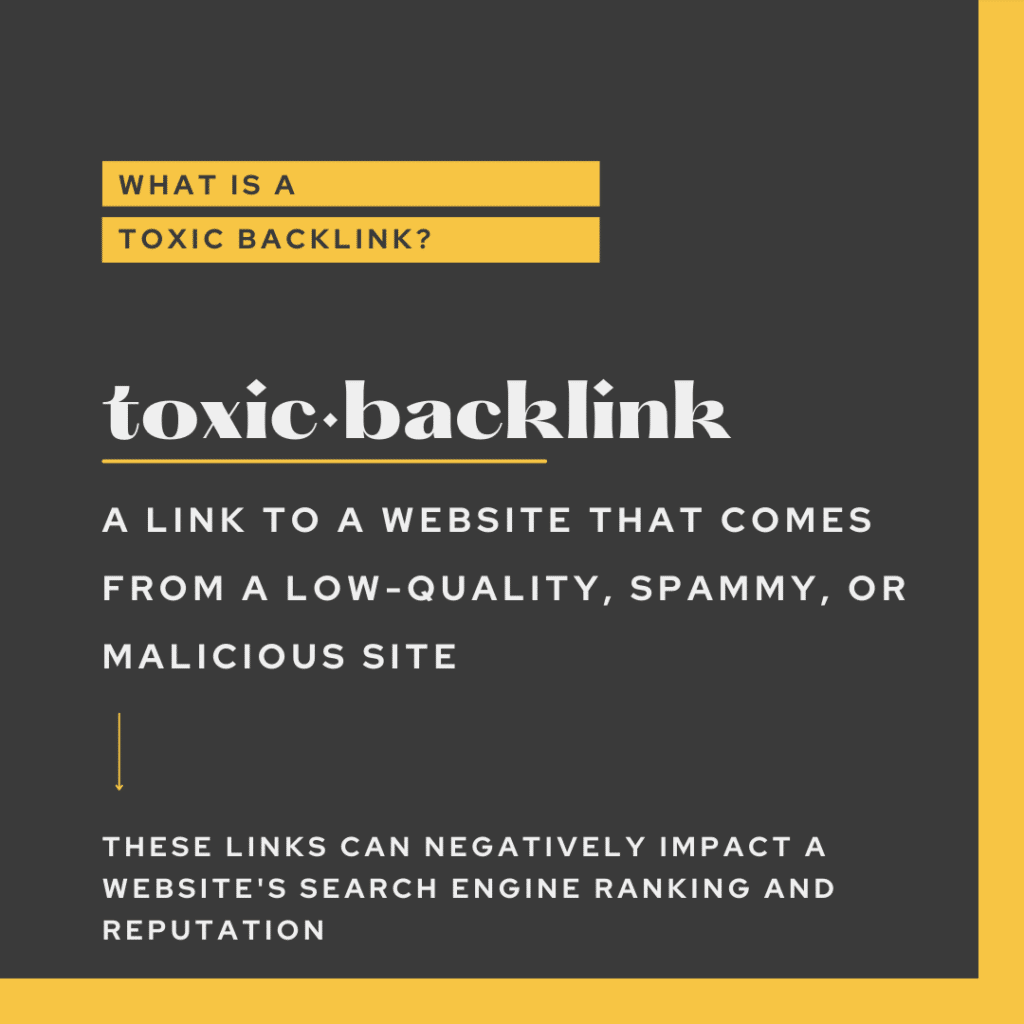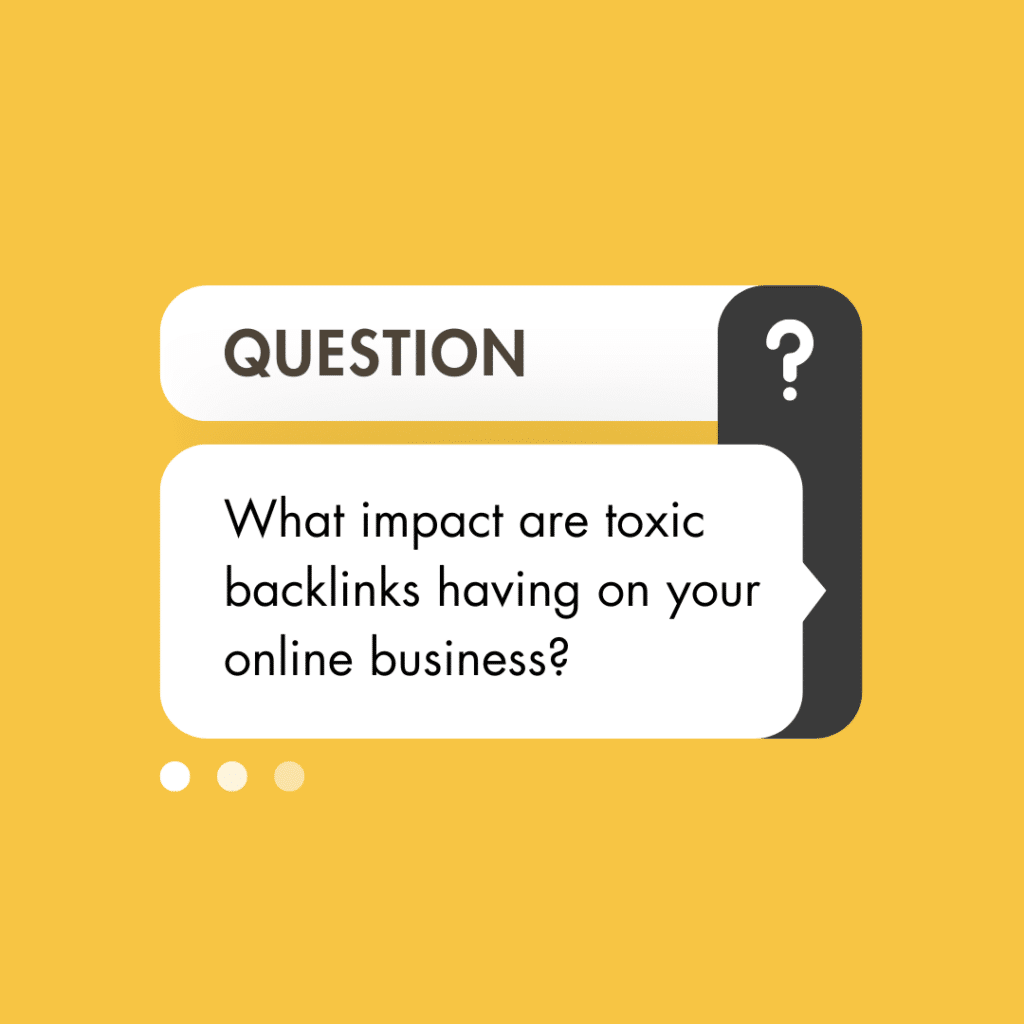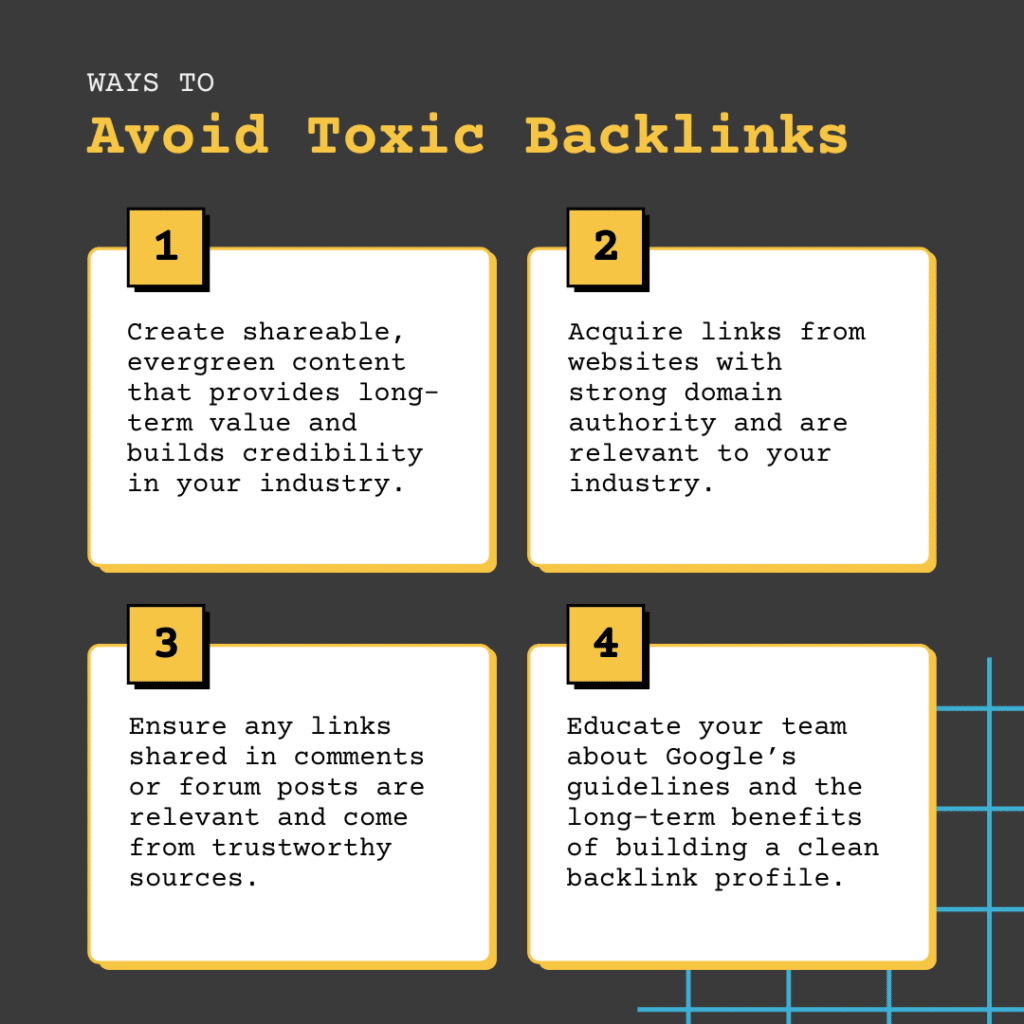Toxic backlinks are a hotly debated topic amongst SEOs across the country. These problematic links can damage a website’s search rankings and reputation. But are they as dangerous as they seem, or have their risks been exaggerated?
Our SEO team has spent hours researching this topic to uncover the truth about toxic backlinks, examine their impact on your site, and provide strategies to safeguard your online presence.
Understanding Toxic Backlinks
As you may already know, backlinks are hyperlinks that send traffic to your website from another source. You can obtain backlinks in various ways, and these links can be powerful tools in your overall SEO strategy.
However, not all backlinks benefit your SEO equally. High-quality backlinks enhance your website’s authority and rankings. In contrast, toxic backlinks can cause significant damage. These harmful links can lead to search engine penalties, lower rankings, and even traffic loss. Not every low-quality link is toxic, but patterns of suspicious links can lead to search engine penalties.

So what defines a backlink as “toxic?”
Critical signs of toxic backlinks include:
- Links from spammy or black hat SEO sites
- Links from irrelevant or poor-quality content
- Links from sites associated with malware or adult content
- Overuse of exact-match anchor text
- Links from link farms or private blog networks (PBNs)
The Consequences of Toxic Backlinks

Negative Impact on Search Engine Rankings
Toxic backlinks can severely damage your search engine rankings. They inform search engines that your site may use manipulative link-building tactics. Search algorithms might penalize your site, causing a drop in rankings. Even with high-quality content, these harmful links can overshadow your efforts, preventing your pages from achieving their full potential in search results.
Potential for Google Penalties
Toxic backlinks pose a severe risk of Google penalties. These penalties can range from a minor ranking drop to complete removal from search results. Google’s algorithms detect and penalize sites involved in unnatural link-building practices.
Google recommends using toxic link reports cautiously. Disavow links if there’s clear evidence of a penalty or manual action for violating web spam policies. These penalties highlight the need to analyze your backlink profile carefully and act only when necessary.
Damage to Online Reputation
Toxic backlinks can damage your online reputation, not just your search rankings. Associating with low-quality or spammy sites can harm how users view your brand.
This negative association may lead to:
- Decreased trust from potential customers
- Lower click-through rates from search results
- Reduced engagement on your website
- Potential loss of business opportunities
Your online reputation is crucial, and toxic backlinks can undermine the credibility you’ve worked hard to build. To protect your positive online presence, regularly monitor your backlink profile and address issues promptly.
Identifying Toxic Backlinks
Spotting toxic backlinks can be challenging, but some tools can help you spot these links and clear them from your backlink profile.
Tools for Detecting Harmful Links
1. Google Search Console
This free tool from Google provides insights into your site’s search performance and backlink profile.
2. Ahrefs
A comprehensive SEO tool that includes a robust backlink checker.
3. SEMrush
Another all-in-one SEO platform with excellent backlink analysis features.
4. Moz Link Explorer
Offers detailed metrics on your backlinks and domain authority.
These tools can help you identify potentially harmful links and give you a clearer picture of your overall backlink profile.
Analyzing Your Backlink Profile
After collecting backlink data, follow these steps to analyze and spot toxic links:
- Review Linking Domains: Assess the quality and relevance of sites linking to you
- Check Anchor Text: Watch for exact-match or overly commercial anchor text
- Examine Link Placement: Be cautious of links in footers, sidebars, or hidden areas
- Assess Link Relevance: Ensure the linking page’s content is relevant to your site
- Monitor Link Velocity: A sudden influx of backlinks may signal a damaging SEO attack
Thoroughly analyzing your backlink profile helps identify issues before they affect your rankings. The aim is to maintain a healthy, diverse link profile that supports your SEO efforts.
Strategies to Avoid Toxic Backlinks
Preventing toxic backlinks is more straightforward than fixing their damage. The easiest thing to do is diversify your link-building methods to avoid looking unnatural. Use techniques like creating shareable content, participating in industry events, and leveraging social media. Also, monitor competitors’ backlink profiles to spot potential issues and opportunities. Stay proactive to maintain a healthy and effective backlink profile.
If you want to be proactive about avoiding toxic backlinks, here are other effective strategies to use:
1. Create Quality Content
The foundation of attracting high-quality backlinks is consistently producing valuable, relevant, and engaging content. Focus on addressing the needs and questions of your target audience using data-driven insights and in-depth research. High-quality articles, how-to guides, infographics, and original research are more likely to earn organic links from authoritative sites. Always aim to create shareable, evergreen content that provides long-term value and builds credibility in your industry.
2. Be Selective with Link-Building
Be strategic and deliberate in your link-building efforts rather than chasing after any possible backlink opportunity. Focus on acquiring links from websites with strong domain authority relevant to your industry and maintain ethical SEO practices. Avoid participating in link schemes, such as buying links or engaging in link exchanges, as these tactics can lead to search engine penalties. Instead, build long-term relationships with reputable websites by offering genuine value through content collaboration, interviews, or case studies.
3. Monitor Your Backlinks
Regularly reviewing your backlink profile is crucial to maintaining a healthy SEO strategy. Utilize tools like Google Search Console, Ahrefs, or Moz to track your backlinks and identify any harmful links. Pay special attention to sudden spikes in backlinks, as they could indicate spammy or toxic links. If you discover any suspicious or low-quality backlinks, consider using Google’s Disavow Tool to prevent these links from negatively impacting your rankings. Consistent monitoring helps catch issues early before they cause damage to your SEO efforts.
4. Implement a Strict Guest Posting Policy
Guest posting can be a great way to build backlinks, but you must have a strict policy. Ensure that all guest posts published on your site or those you submit elsewhere are from credible sources and meet high editorial standards. Avoid low-quality guest contributions that focus solely on backlink acquisition. Set clear guidelines for content quality, relevance, and originality, and avoid keyword-stuffed anchor text or links to dubious websites. Trading posts should follow the same rigorous criteria to protect your site’s reputation.
5. Be Cautious in Forums and Comments
While participating in forums and commenting on blog posts can help build engagement, spammers often target these areas. Ensure that any links shared in comments or forum posts are relevant, contribute to the conversation, and come from trustworthy sources. Avoid over-linking or dropping links that serve no real purpose, as this can lead to penalties or your links being marked as spam. Instead, focus on adding value to discussions and only link when it’s genuinely helpful to the reader.
6. Educate Your Team
Everyone involved in your SEO strategy, from content creators to marketers, must understand the risks of toxic backlinks and the importance of ethical link-building practices. Hold regular training sessions to educate your team about Google’s guidelines, potential penalties, and the long-term benefits of building a clean backlink profile. Encourage collaboration and open communication so your entire team is aligned on link-building goals and strategies, ensuring consistent efforts to avoid toxic backlinks.

Removing Toxic Backlinks
You can contact web admins to remove toxic backlinks or use Google’s Disavow Tool to handle toxic backlinks. We will cover these methods to clean up your backlink profile and safeguard your SEO health.
Contacting Webmasters for Link Removal
Start by reaching out to web admins to remove toxic backlinks. Here’s how to proceed:
- List Toxic Backlinks: Identify which links need removal
- Find Contact Info: Locate the webmaster’s or site admin’s contact details
- Send a Professional Request: Write a clear and polite email asking for link removal
- Track Your Efforts: Record your requests and any responses
Be specific in your request, including the URL of the toxic link. Patience is essential, as responses may take time.
Using Google’s Disavow Tool
If contacting web admins doesn’t work or you have many toxic backlinks, use Google’s Disavow Tool. This tool helps you tell Google to ignore certain links.
Here’s a simple guide:
- Create a Text File: List the URLs or domains of toxic backlinks
- Format Correctly: Follow Google’s guidelines for formatting the file
- Upload to Search Console: Submit the file via Google Search Console’s Disavow Tool
- Monitor Results: Check your site’s performance after disavowing links
Use the Disavow Tool carefully. Only disavow links you’re sure are harmful to avoid affecting good links. If uncertain, consult an SEO expert. Combining webmaster outreach and the Disavow Tool can help clean your backlink profile and boost your SEO. Regular audits and prompt action are essential for maintaining a healthy backlink profile.
Build a Strong Backlink Strategy With InSync Media
Toxic backlinks can be a significant hurdle in maintaining a healthy SEO profile, but you don’t have to face this challenge alone. At InSync Media, we specialize in comprehensive SEO strategies that include building healthy backlinks for you without resorting to black hat techniques.
Our approach combines high-quality, white-hat SEO techniques that improve your Google search engine rankings and protect your site’s reputation. We focus on creating valuable content, executing strategic outreach, and securing guest posting opportunities to attract genuine, authoritative links. We also regularly audit your backlink profile to identify and address potential issues, ensuring long-term success.
Ready to elevate your brand through a comprehensive SEO partnership? Contact us today to book a free discovery call and learn more about how InSync Media can help you achieve your business goals through search engine optimization.
